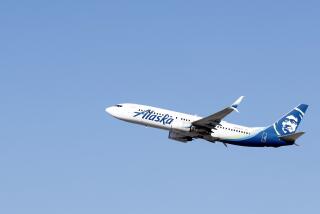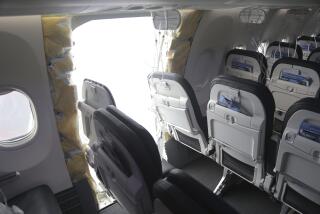Aging Airliners Spark Concern for Safety : More Competitive Industry Leads to Wider Use of Older Planes
WASHINGTON — The crash of a 25-year-old Electra that killed 68 persons in Reno on Jan. 21 is raising concern among some authorities about the nation’s aging airliner fleet--especially the older planes flown by many commuter and newly founded airlines.
Figures compiled by the Air Transport Assn., which represents 30 major U.S. air carriers, show that the average age of the planes operated by the major airlines has more than doubled in the last 15 years, from five years in 1970 to 11 years today.
John Galipault, a former military test pilot who heads the nonprofit Aviation Safety Institute at Worthington, Ohio, points out that the regularly scheduled airlines are using 20-year-old DC-9s and Boeing 707s.
And yet the major carriers “have considerably more up-to-date fleets than the 50 to 60 smaller airlines that operate interstate--mainly commuter and charter airlines,” said William Jackman, ATA’s associate director. For example, the Electra that crashed in Reno was operated by Galaxy Airlines, a three-year-old charter airline.
Officials Not Disturbed
Federal safety officials say they are not disturbed that older airplanes are still in operation.
“It’s not the age of an aircraft, it’s the maintenance that’s important,” said Robert Buckhorn of the National Transportation Safety Board, which investigates all aircraft accidents. “You can keep flying an old plane as long as you maintain it well. But it’s like driving an old car. The older it gets, the more closely you have to watch it.”
One of the older planes in service is the Electra, which is flown largely by charter and commuter airlines. Although Galipault acknowledges that the cause of the Reno crash remains unknown, he says copies of airline maintenance reports received by his institute show that wing cracks have been a recurring problem with Electras over the last five years.
Christopher Witkowski, director of the Ralph Nader-affiliated Aviation Consumer Action Project, said 46 Electras have been involved in accidents in recent years out of 175 such models still in commercial service. The latest occurred last Tuesday, when another Electra owned by Galaxy--a cargo plane carrying hazardous chemicals and auto parts--made an emergency landing in Georgia after having trouble with its landing gear.
The high accident rate shows that “many airlines are trying to cut their costs by keeping up older planes instead of buying new ones,” Witkowski said.
‘Metal Fatigue’
“You cannot avoid metal fatigue in older planes,” Galipault said. “In some cases, the metal changes shape. The aluminum stretches with time and is affected by various stresses.
“You can restore older planes to airworthy condition if you want to pay the price for it,” he said. “For example, it costs $70,000 to overhaul a propeller on the Electra. But it may cost $500,000 to replace one.”
He noted that Galaxy requested and received two 14-day extensions from the Federal Aviation Administration to perform required maintenance on one of four propellers on the Electra that crashed in Reno. The plane crashed 24 hours before the end of the second extension--although there is no evidence that the propeller was the cause.
“We’re not talking about an aged and decrepit fleet,” said John Mazor of the Air Line Pilots Assn. “But a noticeable trend toward older planes has developed since congressional action seven years ago to deregulate the airline industry.”
Cost-Conscious Airlines
The competition sparked by deregulation has made airlines more cost-conscious--and more likely to keep their older planes flying longer rather than replace them. “It’s cheaper than buying new ones,” Mazor said, “and some airlines--particularly smaller ones--cannot afford not to hang onto them.”
Edwin I. Colodny, chief executive officer of USAir, acknowledges that older airplanes are essential for many new companies that have entered the deregulated airline industry. Addressing a recent conference on air safety sponsored by the Flight Safety Foundation of McLean, Va., Colodny said:
“We have older aircraft flying longer. They are flying longer because that is the way you get into the business. Buy an older airplane, fly it and hope that you don’t have a problem before it gets to its next check.”
There is “an inherent conflict between competition and safety improvements,” he said, and the public should understand that safety improvements have “got to come out of the ticket price.”
Jets’ Longer Life Span
The ATA’s Jackman said the fleets of such major lines as American, United, Eastern, TWA and Pan American are also older now than in 1970 because “jets have stayed in the fleets and have a much longer life span than the old propeller planes. Some jets have been re-engined and are operating with new, quieter engines.”
Some of the safest and most popular planes, such as the Boeing 727, are among the oldest, he said. “Over the years you replace a lot of an airplane,” he added. “If they’re continually maintained and overhauled on a regular basis, they’ll fly forever.”
The Federal Aviation Administration, which regulates the inspection and maintenance by airline mechanics of all the components of an aircraft, assigns a “principal maintenance inspector” to oversee the maintenance program of each major airline. In the case of smaller airlines, one FAA inspector may handle two or three companies.
But Galipault of the Aviation Safety Institute said the FAA, as exemplified by its deferral of Galaxy Airline’s propeller work, is often “too easy. They try to be nice guys and accommodate the airlines.”
More to Read
Sign up for Essential California
The most important California stories and recommendations in your inbox every morning.
You may occasionally receive promotional content from the Los Angeles Times.









